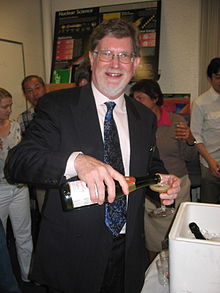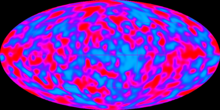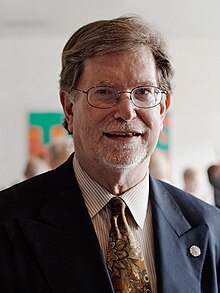George Smoot


George Fitzgerald Smoot III (born February 20, 1945 in Yukon , Florida ) is an American astrophysicist and Nobel Prize winner.
Life
Smoot was the older of two children by a teacher and a hydrologist . In 1966 he obtained a Bachelor of Science degree in mathematics and physics from the Massachusetts Institute of Technology and completed his doctoral thesis in 1970 in the field of particle physics on the decay of subatomic elementary particles . Since many scientists were doing research in the field of particle physics at that time, he decided to switch to the less frequented research field of cosmology . In the same year he switched to the working group of Nobel Prize winner Luis W. Alvarez at the University of California at Berkeley. There he worked at the Lawrence Berkeley Laboratory on the NASA project HAPPE (High-Altitude Particle Physics Experiment) with the aim of designing an experiment that could provide evidence for the Big Bang theory .
In 1988 he became a Fellow of the American Physical Society . He has been a member of the National Academy of Sciences since 2008 .
COBE
In 1976, NASA decided to design a satellite that would be able to measure the cosmic background radiation from space. Among the scientists who contributed to this project, was also George F. Smoot, who with his group a detector, a Differential Microwave Radiometer , which was developed (Differential microwave radiometer, DMR) capable of anisotropies in the microwave background to be measured. On November 18, 1989, the COBE satellite , equipped with this detector and instruments from the working groups of John C. Mather and Mike Hauser , was launched into orbit with a Delta launcher.
Smoot's DMR collected data on the anisotropy of cosmic background radiation in the microwave range for about four years , so it was possible to create a complete map of this phenomenon (see picture). This microwave background radiation is considered to be a kind of echo of the Big Bang . The intensity fluctuations allow conclusions to be drawn about density fluctuations shortly after the creation of the universe. It is assumed that precisely these fluctuations in density are the cause of today's appearance of space, with its galaxy clusters and huge regions of further emptiness.
Smoot was awarded the Nobel Prize in Physics in 2006 together with John C. Mather for confirming that the spectrum of background radiation obeys Planck's law of radiation of a black body and the discovery of the anisotropy of the cosmic microwave background ( for their discovery of the blackbody form and anisotropy of the cosmic microwave background radiation ) excellent.
Trivia
Smoot had a guest appearance (as himself) in the popular US comedy series The Big Bang Theory (episode 2x17), which he allegedly received as a fan of the series on his own initiative. In 2019, he and other Nobel Prize winners made another guest appearance in the last season of the series.
On September 18, 2009, Smoot was a candidate in the US game show Are you smarter than a 5th Grader? and won a million dollars. He was the second candidate to do that.
literature
- Angelica de Oliveira-Costa and George F. Smoot: Does COBE rule out a toroidal Universe? In: Nuclear Physics B, Proceedings Supplements , Volume 43, 1995, pp. 299-302, doi: 10.1016 / 0920-5632 (95) 00495-U .
- George F. Smoot: COBE observations of the cosmic background . In: Frontiers Science Series . Volume 8, 1994, pp. 115-136.
Web links
- George Smoot's CV. ( May 23, 2009 memento on the Internet Archive ) University of South Dakota
- Homepage of the working group. ( May 23, 2009 memento on the Internet Archive ) Lawrence Berkeley National Laboratory
- Information from the Nobel Foundation on the 2006 award ceremony for George F. Smoot
- The big bang detective . Telepolis , February 5, 2007
Individual evidence
- ^ Biography of George F. Smoot
- ^ GF Smoot: COBE: New sky maps of the early universe. In: Astrophysics and Space Science Library , Volume 169, 1991, pp. 281-294, doi: 10.1007 / 978-94-011-3410-1_44 .
| personal data | |
|---|---|
| SURNAME | Smoot, George |
| ALTERNATIVE NAMES | Smoot, George Fitzgerald III (full name) |
| BRIEF DESCRIPTION | American astrophysicist |
| DATE OF BIRTH | February 20, 1945 |
| PLACE OF BIRTH | Yukon , Florida |
